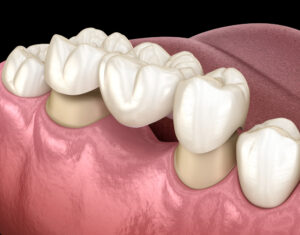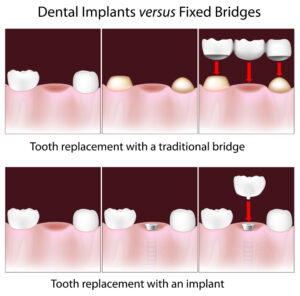How Does a Dental Bridge Work?
 Before dental implants gained popularity and stability as a tooth replacement option, dental bridges took center stage. While we do love dental implants and help many of our patients restore great chewing function with them, a dental bridge may be a better tooth replacement option in many cases. We will explain bridges in this week’s blog. What is important for you to understand is that tooth replacement does not work under a one-size-fits-all approach. In order to get the best long-term restoration of your missing tooth, it is essential that you work with your dentist to choose the best option for your unique situation.
Before dental implants gained popularity and stability as a tooth replacement option, dental bridges took center stage. While we do love dental implants and help many of our patients restore great chewing function with them, a dental bridge may be a better tooth replacement option in many cases. We will explain bridges in this week’s blog. What is important for you to understand is that tooth replacement does not work under a one-size-fits-all approach. In order to get the best long-term restoration of your missing tooth, it is essential that you work with your dentist to choose the best option for your unique situation.
What is a Dental Bridge?
A dental bridge is officially a Fixed Partial Denture or FPD. “Fixed” means that it is not removable but attached or affixed in your mouth. “Partial” means that it replaces some, but not all, of your teeth. “Denture” is a dental term describing prosthetic (or fake) teeth.
A traditional dental bridge consists of two retainer crowns, which sit over the teeth on both sides of the missing one(s), and pontics, which are the fake teeth to replace the missing one. A bridge requires two healthy teeth neighboring the missing tooth space because they must support the additional force or weight of the pontic. We call bridges by their number of units, which is always the two retainer crowns plus the number of pontics. So a bridge replacing a single missing tooth would be a three unit bridge.
How Does a Dental Bridge Work?
 A bridge uses traditional dental crowns that cover the entire exposed portion of teeth to connect the teeth on both sides of a missing space. The bridge itself, regardless of how many units it contains, is a single piece of metal, porcelain, or some combination of the two. In a three unit bridge, the three “teeth” are connected together. The crowns cover and rest on top of the retainer teeth, and the pontic, connected to them, is suspended on top of the gums of the missing tooth space.
A bridge uses traditional dental crowns that cover the entire exposed portion of teeth to connect the teeth on both sides of a missing space. The bridge itself, regardless of how many units it contains, is a single piece of metal, porcelain, or some combination of the two. In a three unit bridge, the three “teeth” are connected together. The crowns cover and rest on top of the retainer teeth, and the pontic, connected to them, is suspended on top of the gums of the missing tooth space.
A bridge only “works” when the two neighboring teeth can provide adequate support for the additional chewing force the pontic will provide. It functions to replace the lost tooth and its chewing surface. It does not however replace the root of the missing tooth. Without a root for support, all of the support for a dental bridge comes from the adjacent retainer teeth.
How Many Teeth Can a Bridge Replace?
Great question!
You may get different answers from different dentists, too. Opinions have gradually changed over the years as long-term studies show that the longer a bridge span is, the shorter its life span is. The more teeth you attempt to replace, the worse the long-term prognosis. In general, bridges do well to replace one or two missing teeth.
The success of a longer span of teeth rests solely on the health and strength of the underlying retainer teeth. For example, a bridge resting on a big strong first molar and long-rooted canine to replace two missing premolars would probably have good long-term success. Ideally, the supporting teeth will be much larger and stronger than the missing teeth being replaced.
In Which Cases are Dental Bridges a Great Treatment Option?
There are several scenarios that could make a dental bridge your best tooth replacement option. Here are a few of the cases that could lean that direction.
Esthetic Concerns
We are able to create beautiful cosmetic results with dental implants in most cases. However, there are some cases of missing front teeth that Dr. Ann can restore best and most esthetically with a dental bridge. At Designer Smiles, a beautiful, natural smile is our priority for each patient. Dr. Ann will describe every treatment option and explain why one may lead to a better cosmetic result than another may.
Lack of Healthy Bone
 A dental implant may not be an option for tooth replacement in an area of the mouth due to a lack of healthy bone. Dental implants require a specific amount of bone in height and width to surround and support them. If the missing tooth site suffered significant bone loss, the implant is not an option.
A dental implant may not be an option for tooth replacement in an area of the mouth due to a lack of healthy bone. Dental implants require a specific amount of bone in height and width to surround and support them. If the missing tooth site suffered significant bone loss, the implant is not an option.
Because a dental bridge does not anchor into the bone, but rests on top of the teeth and gums, it is a great option when healthy bone is lacking.
Adjacent Teeth Require Dental Restoration
A bridge requires dental crowns covering the neighboring teeth. When these teeth already have crowns or have dental conditions necessitating coverage with crowns, a bridge is a wonderful option that allows you to kill two birds with one stone. (The birds being the need to cover the teeth with crowns and the need to replace a missing tooth. The stone being the bridge.)
If you must cover the two neighboring teeth with crowns, you might as well connect them and fill in the missing tooth space!
Health Concerns
Some patients have health concerns or medical conditions that contraindicate the placement of dental implants. Implants require a surgical step to place them into the jawbone. Many people are unable to tolerate the surgical process and would fare better with a dental procedure that does not affect the gums and underlying bone.
How Do I Know Which Tooth Replacement Option is Best for My Missing Tooth?
At Designer Smiles, we prefer to take on the role of a consultant in your dental decisions. We believe that it is our responsibility to educate you on the various treatment options and your unique factors that will affect the success of each option. Then we perform the treatment you decide best meets your needs and desires.
Dr. Ann will perform a thorough evaluation of the site of your missing tooth, gathering all the information necessary to discern potential risks or complications. In some cases, it may be obvious that one treatment is far superior to another, and in others, both dental implants and bridges could be viable options. In the obvious cases, she will honestly tell you which option is far superior. In the cases that could achieve success in different ways, she’ll help you decide which is best for you.
More Questions about Dental Bridges?
Call Designer Smiles today to schedule a consultation with Dr. Ann. She is an expert in replacing missing teeth with multiple treatment options.
